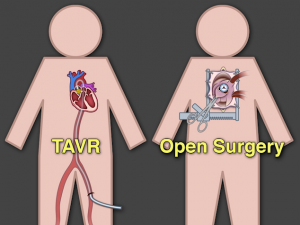In today’s Transcatheter Aortic Valve Replacement (TAVR) Procedure story, The New York Post shares the experience of, Perry Cimons. Then 76, and a retired pharmacist from Yonkers, N.Y., Perry Cimons underwent open-heart surgery to replace his deteriorating aortic valve. He spent eight days in the hospital and was back to normal after two months. His was the usual treatment for an otherwise healthy patient: Cut into the chest through the rib cage, then go directly into the heart and swap the bad valve for a good one.
“I was pretty sore, but the pain went away over time, and by the first week of January I was back on the treadmill,” he says.
Within the next few years, based on the results of a study now underway, people like my brother
might be able to choose a less-invasive option that would get them home within three days and take
half the recovery time, although, as with most procedures, there are risks.
Transcatheter aortic valve replacement (TAVR) is a minimally invasive procedure for patients who
need a new aortic valve due to aortic valve stenosis but who are at high risk for open-heart surgery.
Ashchi Heart & Vascular Center has cardiology experts who specialize in the TAVR procedure. We
use the latest technology and techniques to deliver the highest quality, patient-centric care. We also
welcome patients seeking second opinions on their treatment options.
About 8 million Americans suffer from heart valve diseases at any given time, with nearly 6 million
diagnosed annually, according to the American Heart Association. It includes such symptoms as
shortness of breath, lightheadedness or fainting, and chest pain.
If you or a loved one shows any symptoms of heart–valve diseases, we encourage you to make an
appointment with one of our specialists. Please contact us at (904) 222-6656.
